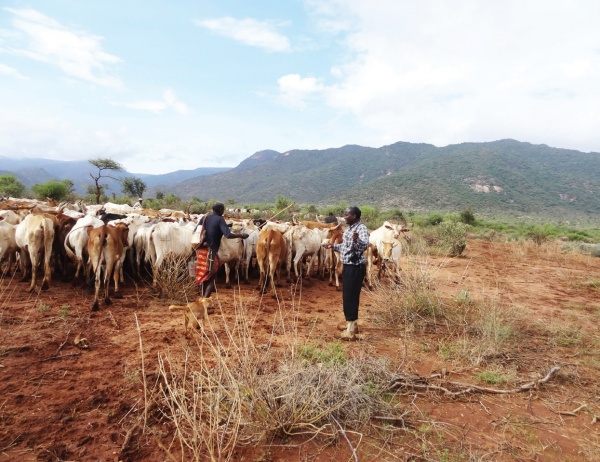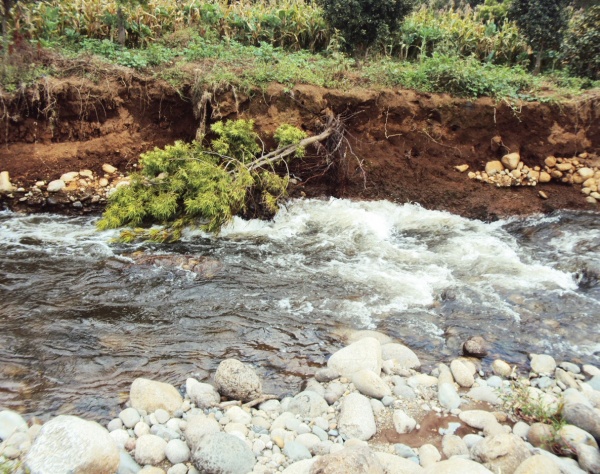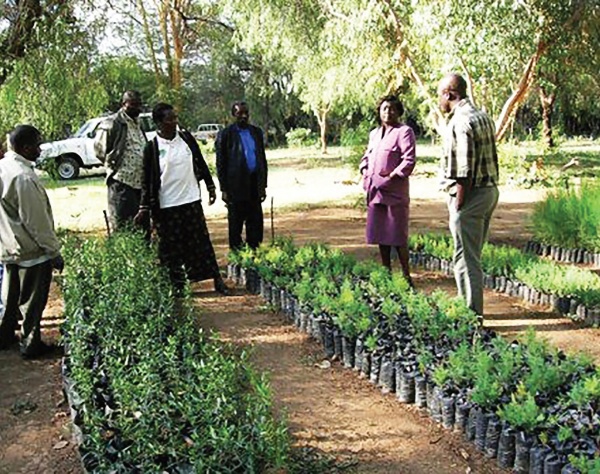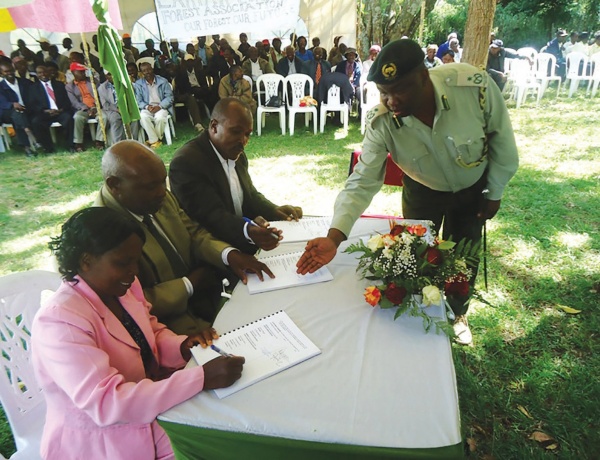Improving natural resource management and biodiversity conservation in the Laikipia county ecosystem, Kenya
25.08.2016
-
SUBMITTED ORGANISATION :
-
Laikipia Wildlife Forum
-
DATE OF SUBMISSION :
-
25/08/2016
-
REGION :
-
Eastern Africa
-
COUNTRY :
-
Kenya (Laikipia County)
-
SUMMARY :
-
Majority of people living in rural areas in Kenya derive goods and services from the available natural resources. However, their livelihood activities contribute to gradual environmental degradation, resulting in loss of the very resources on which they depend. The Laikipia Wildlife Forum (LWF) is a community-based organization trying to balance the livelihood needs of the people and the ecological integrity of their ecosystem. LWF focuses on participatory forest, pasture, and water resource management, aiming to enable local communities to maintain and restore the health of the ecosystem and increase land productivity. Local resource users use Holistic Management principles through which community decision-making groups such as Community Forest Associations (CFA), Water Resource Users Associations (WRUA), and Group Ranch Management Committees govern themselves. This approach has been found to benefit from the close connection with traditional knowledge and governance systems integrated with new knowledge and practices. The results of this strategy show that engagement of communities in natural resource management results in improved decision-making skills, expansion and diversification of economic opportunities, enhanced ecological and socioeconomic monitoring, and improved governance and transparency in relation to the health and management of the Laikipia ecosystem.
-
KEYWORD :
-
Kenya, Laikipia county, Livelihood, Landscapes, Ecosystem
-
AUTHOR:
-
Josephat M. Musyima (Laikipia Wildlife Forum)
-
LINK:
-
https://collections.unu.edu/eserv/UNU:5769/SEPLS_in_Africa_FINAL_lowres_web.pdf
Summary Sheet
The summary sheet for this case study is available here.
Introduction: natural and social background
[Note: this case study was originally published in the publication “Socio-ecological Production Landscapes and Seascapes (SEPLS) in Africa“]
All over the world, communities engage directly with the environment through primary activities such as farming, fishing, and gathering resources from ecosystems and by doing so have the responsibility of maintaining socio-ecological landscapes and seascapes (SEPLS). Through close interactions with nature, people have developed efficient and sustainable ways of living and producing food and other materials by adapting to and sometimes modification of the surrounding environment (Ichikawa 2012). In this case study, the Laikipia county ecosystem, located in the Rift Valley province of central Kenya, is explored as an example of SEPLS in Africa contributing to human well-being and ecosystem sustainability.
The Laikipia ecosystem is centered on the upper Ewaso Ngiro river system, with over thirty rivers and streams feeding into the Ewaso Ngiro river, which flows into northern Kenya. The forest areas lie mostly in the wetter upper part of the river catchment and include those on the lower slopes of Mount Kenya and the Aberdare range and also five forest areas in the west of Laikipia (Figure 1).
Land tenure in Laikipia is characterized by both private and communal land ownership. The livelihood systems reflect the ecological and climatic characteristics of the area. Livestock-based livelihoods dominate in most of Laikipia, through large-scale ranches and nomadic/transhumant pastoralists. Small-scale cultivation can be found along the rivers where irrigation occurs and on the west and south of Laikipia where rainfall is higher than 600 mm.
There is high pressure on natural resources, notably rangeland resources and river water, in the more densely populated pastoralist and smallholder cultivation areas. Poor livestock management in addition to water scarcity and increased population has led to the degradation of large tracts of land (Gu & Subramanian 2014). Unsustainable use of forest resources has become the norm, as traditional resource management systems have mostly collapsed and have not yet been replaced by strong adapted management systems. These trends exacerbate global climate change impacts, which appear to take the form of increasingly unpredictable rainfall with more frequent storm occurrence.

Figure 1: Geographical location of the Laikipia in the context of Kenya. Source: Laikipia Wildlife Forum
Functions and benefits of the Laikipia county ecosystem
Production and supply of biodiversity and ecosystem services
A range of benefits accrue to the well-being of households and communities of the Laikipia County through the ecosystem services derived from various sustainable uses of land. In addition, the ecosystem contributes to creating sustainable societies, as it encompasses production activities that maintain both biodiversity and ecosystem services. Human productive activities such as agriculture, forestry, herding, and livestock rearing influence the Laikipia ecosystem. Although these engagements may have adverse effects on the environment, many such longterm human-nature interactions, as seen in other SEPLS, can in fact be favorable to or synergistic with biodiversity conservation (UNU-IAS et al. 2014).

Photo 1: Group ranch grazing committee being trained on the need for proper grazing practices. Photo credit: Laikipia Wildlife Forum
The Laikipia ecosystem is critical for the supply of provisioning ecosystem services including food, fuel, plants of medicinal value as well as serving as a source of livelihood for the resident communities through the cultivation of various crops, vegetables, fruits, and trees for timber, forage, and fodder. It also provides pasture for livestock and wildlife. Another major role of the ecosystem is the provision of critical supporting, cultural, and supporting ecosystem services, including curbing soil erosion, enhancement of soil fertility, promotion of water quality, recreational values, supporting pollination, and carbon sequestration.
Forests in the wider Laikipia ecosystem are conservation-diverse. This is often attributed to their geographic spread across a steep rainfall gradient and the direct interconnectedness with the grasslands and dryland woodlands as a result of the movement of wild animals. As with river water resources, the primary mechanism to bring about effective management and restoration of forests in a human-occupied landscape such as Laikipia is community-based organizations. This is recognized in the law through the Forest Act with establishment of Community Forest Associations (CFA) and the implementation of participatory forest management (PFM) (Government of Kenya 2005).

Photo 2: Livestock bunching to facilitate water infiltration to enhance new growth. Photo credit: Laikipia Wildlife Forum
The essential services provided by forests to the people, environment, and wildlife of Laikipia include watershed protection, emergency or dry-season grazing, a wide range of traditional non-timber forest products (food and medicinal plants, fungi, etc.), habitats and forage, and timber products such as firewood. Laikipia county forests also provide a sink for carbon, a recognized need at a global level (Pan et al. 2011).
The Laikipia Wildlife Forum (LWF) program supports the creation and strengthening of CFAs to enable effective implementation of PFM. Through these CFAs, for example, appropriate human interventions such as periodic tree cutting, coppicing, and grazing contribute to conserving the unique biodiversity of mixed woodland and grassland landscapes, particularly in temperate regions.
River water resources are a pillar of existing livelihoods and human sustenance, as well as essential for ecosystem health. The national Water Resource Management Authority (WRMA) and the Ewaso Nyiro North Development Authority (ENNDA) estimate that the water needs of 92% of the upper Ewaso Nyiro system’s population is met by surface water rather than groundwater resources, the great majority being met by river water. Every piped water scheme serving rural and urban communities in the ecosystem is served directly by flowing river water. These schemes include all of Laikipia’s human population and the work area of the LWF.
Based on Kenya’s 2009 population census, the number of people directly dependent on surface water resources, especially rivers, is 165,600 households (Government of Kenya 2010). There is no doubt that the availability of sufficient clean drinking water for people in the ecosystem is directly linked to the overall management of river water resources and related environments.
The LWF activities have focused on three priority areas: PFM, pasture management, and water resource management. The objective of the forest management program is to enable LWF members and the local communities in Laikipia to maintain and or restore forest health and productivity.
Application of local knowledge practices and systems in management of the Laikipia county ecosystem
Community participation is essential, given that the community is usually the primary user and manager of the natural resources in their landscapes. Owing to their extensive and close interaction with their ecosystems, local communities possess abundant information and deeper knowledge of how ecosystems react to different management practices and how they recover from natural disasters and change over the long term.
In Laikipia local communities, particularly the transhumant pastoralists, indigenous knowledge has been key to the conservation of natural resources. Various attempts have been made to restore degraded lands, including grass reseeding, digging trenches to reduce surface runoff, and establishment of grazing management committees to enforce traditional grazing management regimes. These attempts have raised communities’ awareness on the importance and potential for restoration and rehabilitation of grasslands despite the changing economic, social and cultural context.
In other approaches, the group ranches have established zonation maps to demarcate areas for settlement, grazing, and conservation, because the pastoralists are becoming increasingly sedentary. This approach involves local communities themselves designating areas for dry and wet season grazing, which allows the land to recover under the rotation. This is based on the communities’ knowledge of the spatial distribution of water resources and pasture, settlement patterns, and other areas of spiritual/cultural value.
Conventional wisdom has advocated destocking as a way of controlling overgrazing and soil erosion, but this practice is not culturally acceptable in Laikipia, where social well-being is culturally associated with livestock herds. The Holistic Management (HM) approach seems to be favorable in this landscape because it does not involve destocking. According to Savory (1999) overgrazing is a function not of number but of time. It is due not to the intensity of livestock on the land but to the time during which the livestock stays in the same area. HM thus aims at improving plant cover to increase rainfall effectiveness (reducing evapotranspiration and runoff) using animal impact to improve soil quality.
The approach resonates well with traditional practices and transhumant communities have readily embraced it in some sections of the Laikipia landscape, despite the challenges of a weakening traditional governance system under the influence of modern activism.
Major threats and impact to livelihoods
The rapidly growing human population has brought with it large changes in socioeconomic systems, such as land fragmentation and inappropriate agricultural and settlement practices (intensified cultivation, expansion of cultivated land, overgrazing, harvesting of fuelwood, charcoal burning, and inappropriate irrigation). This has contributed toward environmental degradation and a breakdown of ecosystem services. This in turn leads to major problems such as deforestation, acute water shortages, loss of biological diversity, and soil erosion, as well as deterioration of life support systems, including air, water, and land (Gachathi & Amwatta 2005).

Photo 3: Riparian degradation as a result of farming adjacent to rivers. Photo credit: Laikipia Wildlife Forum
Other challenges to ecosystem management activities result from shocks due to natural and human-induced phenomena, such as droughts, wildfires, and floods. Human activities and events such as political upheavals and economic crises further affect the landscape and inevitably affect local communities’ livelihoods. In addition, global phenomena such as climate change and transformation of sociocultural and institutional structures directly and indirectly affect the use and management of the Laikipia ecosystem.
The forests of Laikipia are under threat from anthropogenic disturbances ranging from deforestation by illegal logging and charcoal production to retardation of forest regeneration due to intense grazing. The resulting forest loss has direct negative consequences for both livelihoods and biodiversity in the ecosystem, and because forests have critical watershed functions and Laikipia is a water-stressed environment, forest loss may have serious implications for the wider surrounding nonforest areas.
Additionally, the process of establishing CFAs has presented challenges, including difficulties in finding committed leadership for the associations and delays occasioned by the restructuring of the Kenya Forest Department (KFD) into the Kenya Forestry Service (KFS), a process that began in 2007. However, although committee members of CFAs understand the responsibilities attached to communities’ involvement in forest management under the New Forest Act, very few people apart from these committee members have a good grasp of their rights and obligations for forest resource use and management (Government of Kenya 2005).
The larger land area of Laikipia (>70%) is semiarid rangeland supporting extensive livestock rearing among the transhumant pastoralists whose livelihoods are based almost entirely on livestock. According to a report from the Ministry of Environment and Mineral Resources these pastoralist communities own approximately 7% of Laikipia as private group ranch land, but use and depend on at least 25% of Laikipia county. Most of the land is owned by cultivating peoples. Forest areas in the Laikipia ecosystem are important dry-season and emergency grazing areas, notably the Mount Kenya forest, in periods of severe drought. Of Laikipia’s rangeland, 40% is under largescale ranching and hosts most of Laikipia’s wildlife. Wildlife-based photography tourism has increased in the rangelands in the last decade, influencing land use patterns in both private ranches and communal group ranch land. Both extensive livestock rearing and photography tourism depend on the same natural resource base, namely plants to sustain wild and domestic herbivores. The land’s primary productivity, particularly in communally-owned and used areas, is degraded, with concomitant negative consequences for livestock-based livelihoods (Gachathi & Amwatta 2005).
Responses
LWF is a membership-based organization that brings together local community groups, pastoralists, small scale farmers, private ranches, large scale farmers, and tourism ventures. They are united by a common mission: to conserve the integrity of the Laikipia ecosystem by creatively managing natural resources to improve the livelihoods of its people. Fundamental to the work of the LWF is the recognition that all livelihoods in Laikipia are directly dependent on locally available natural resources.
The overall goal of the LWF is to increase the capacity of the people of Laikipia to manage their natural resources including rangelands, forests, and water by using strategies such as conducting trainings that aim to improve governance at the group ranch and producer group levels, improving decision-making skills in relation to the health and management of natural resources, expanding and diversifying economic opportunities for Laikipia communities, developing a Laikipia-wide ecological and socioeconomic monitoring program to track changes in ecosystem health and human well-being, and improving governance and transparency at community and producer group levels.
The activities undertaken by the LWF have been focused on increasing natural resource management capacity in the Laikipia ecosystem. The work has contributed to the implementation of new national natural resources legislation that recognizes the need for devolution of natural resource management to the user level within the framework of management plans (e.g., Forest Act, Water Act). The LWF has been investigating mechanisms to mitigate land degradation through land restoration and has been creating economic incentives to restore land productivity through enterprise. However, conflicts over scarce resources occur with respect to rangeland, water, and forest resources (Bond 2014).
To enable its members and Laikipia’s communities to protect and sustainably use forests, the LWF has focused on building the capacity of forest users to participate actively in management. Programs have accordingly been established for PFM, pasture management, and water resource management. To enhance the capacity of local communities in Laikipia to protect and sustainably use forests, sought to promote the capability of forest users to participate actively in their management. This was achieved by raising awareness of and providing training to community leaders and members, so as to make forest users more aware of their rights and obligations with respect to forest use and management under the Forest Act (2005). For instance, leaders of the group ranches surrounding the Mukogodo forest were trained to broaden their understanding of the group ranch’s responsibilities with respect to resource management.
The rangeland management program focused on investigating and training communities in a diversity of methods to control erosion and increase grass cover on the land. This was implemented with the aid of fenced demonstration plots, branch lopping, and reseeding. It entailed the establishment of two 20-ha plots where grass was seeded, aloes planted on contours, and terraces formed. At the same time, lopping of tree branches to lay on bare ground to trap water, soil, and seed was performed and reseeding was supported on a 500-ha area. Although the demonstration plots succeeded as awareness-raising tools, showing that grass could come back to the bare land, it became apparent that the prohibitive cost of the methods (fencing, plowing, terracing, planting, etc.), and the lack of integration of these approaches within a wider rangeland management and land use decision-making framework meant that these methods or approaches could not be adopted on the necessary scale on all the land used by the pastoralists.
Another approach involved supporting Group Ranches around the Mukogodo forest to develop and implement grazing management plans. This approach comprised activities such as identification and mapping of dry and wet season grazing areas and the formulation of bylaws in cooperation with the leadership of the group ranches. This activity enabled the restoration of the land to be considered together with broader environmental conservation and management and local economic development.
Whilst focusing on introducing the Holistic Management (HM) principles in community areas, and in response to the strong interest in the approach by the different types of land owners in Laikipia (communal and private) and from elsewhere, targeted introductions and trainings aimed at getting private ranches on board the process and increase their understanding of the approach are being employed (Savory & Butterfield 1999).
Water Resource User Associations (WRUAs) are legally mandated community-based organizations involved in the management of the water resources on which their livelihoods depend (Government of Kenya 2002) The WRUAs are membership-based, anchored in the community of land (riparian and catchment) owners and water users, and established to resolve problems of water abstraction, poor land husbandry, weak water allocation systems, and catchment management at the river level. The role of the WRUAs is to establish dialogue between land users along a river (from upstream to downstream), mitigate conflicts, and put in place and implement management plans for their rivers. In order for river water management to be effective and water to be available to households, the creation of functional WRUAs is paramount (Government of Kenya 2006).
Because downstream communities and environment are vulnerable to the weak management of upstream water resources and catchment areas, the river water resources management program is initially concentrating on strengthening the management of water resources in the upper part of the catchment. A key element of the program is to raise awareness of upstream communities of the link between their activities and downstream water availability.
The LWF has successfully supported the formation and strengthening of 26 WRUAs in the Laikipia ecosystem, with work ongoing to develop Sub-Catchment Management Plans (SCMPs) to guide future water resource management activities within each sub catchment.

Photo 4: Community Forest Association members raise seedlings in nurseries. Photo credit: Laikipia Wildlife Forum
Recommendations
Few people understand the importance of good forest management for their livelihoods; besides, there is little understanding among community members of the relationship between the health of the forest and the health of the ecosystem as a whole, in particular the role that forests play in water availability beyond the locality. Although various approaches are considered to help in the reversal of negative trends in SEPLS, the engagement of the local communities is essential, given that members of these communities are primary users and managers of the local ecosystem. In addition, they possess abundant information on how local ecosystems react to different management practices, recover from natural disasters, and change over the long term, as a result of their frequent interaction with the environment.
Management of SEPLS must incorporate sound decision-making processes and embrace holistic management strategies that are of direct relevance and value to the given ecosystem. This is because such strategies bring new knowledge and understanding of the range of tools (technology, rest, fire, grazing, and animal impact) available to land managers and of the impact of each on the four ecosystem processes that sustain life [water cycle, nutrient cycle, energy flow, and succession (of plant, animal, and other communities)]. Holistic management also focuses on knowledge transfer to land managers, which is vital for on-the-ground capacity and long-term sustainability.
The strategies used also revealed that management planning and better-informed decision-making is more effective in restoring health to the communal rangelands than technological interventions. In the context of Laikipia, holistic management provided guiding principles for an integrated approach to planning and decision making. But it is noteworthy that such interventions must develop through a process that is acceptable within the local economic, social, and environmental context. The challenge; however, may lie in attaining coordinated implementation among expansive populations of livestock owners, decision-makers, and managers.
There is need to ensure sufficient cooperation between users within the SEPLS. This is born of the finding that though cooperation may be difficult to achieve, such ensures that planning is more adaptive, and rely on collaboration, with a focus on livelihood activities such as herding together, moving at the same time, leaving grass to recover sufficiently. The identification and training of a core team of people to lead the process in each community enhances the uptake of the approaches, as this practice enables communities to understand more quickly the concepts involved.

Photo 5: Signing the Forest Management Agreement. Photo credit: Laikipia Wildlife Forum
References
Bond, J 2014, ‘A holistic approach to natural resource conflict: The case of Laikipia County, Kenya’, Journal of Rural Studies, vol. 34, no.2014, pp.117-127.
Gachathi, FN & Amwatta, M 2005, A vital habitat and drought coping strategies in dry lands: The case of Endau hilltop forest, Kitui District, Kenya, International Human Dimensions Programme on Global Environmental Change (IHDP), Bonn, Germany.
Government of Kenya 2002, The Water Act, 2002, Laws of Kenya. Nairobi, Kenya.
Government of Kenya 2006, The Water Resources Management Rules, In Kenya Gazette Supplement, Government Printer.
Government of Kenya 2010, 2009 Kenya Population and Housing Census, Volume 1A, 1B, 1C and Volume II, KNBS, Nairobi, Kenya: Government Printer.
Government of Kenya 2005, Forests Act. Nairobi, Government Printer.
Gu, H & Subramanian, SM 2014, Drivers of change in socioecological production landscapes: Implications for better management, Ecology and Society vol.19, no.1, http://dx.doi.org/10.5751/ES-06283-190141.
Ichikawa, K (ed.) 2012, Socioecological production landscapes in Asia. United Nations University Institute for Advanced Study (UNU-IAS). Viewed 10 December 2015, https://satoyama-initiative.org/old/wp/wp-content/uploads/2015/04/SEPL_in_Asia_report_high_quality.pdf.
Ministry of Environment and Minerals Resources 2012, Masterplan for the Conservation and Sustainable Management of Water Catchment Areas in Kenya, Nairobi.
Pan Y, Birdsey RA, Fang J, Hougton R, Kauppi EK Kurz WA, Philips OL et al. 2011, ‘A Large and persistent carbon sink in the world’s forests, Science, vol. 333, no.6045, pp. 988-993.
Savory, A & Butterfield, J, .1999. Holistic Management: A New Framework for Decision Making, Island Press, Washington DC, USA.
UNU-IAS, Bioversity International, UNDP& IGES 2014, Toolkit for the Indicators of Resilience in Socio-ecological Production Landscapes and Seascapes (SEPLS), viewed 12 November 2015, https://satoyama-initiative.org/old/wp/wp-content/uploads/2014/11/TOOLKIT-X-WEB.pdf.

